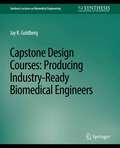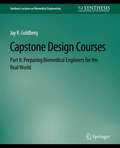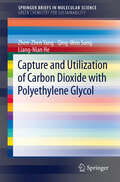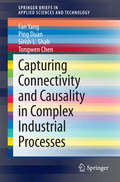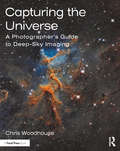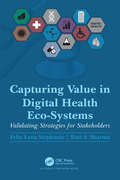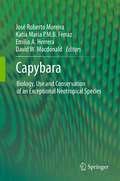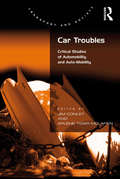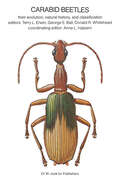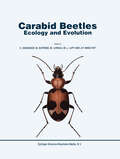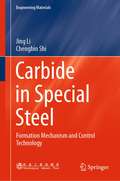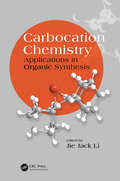- Table View
- List View
Capstone Design Courses: Producing Industry-Ready Biomedical Engineers (Synthesis Lectures on Biomedical Engineering)
by Jay GoldbergThe biomedical engineering senior capstone design course is probably the most important course taken by undergraduate biomedical engineering students. It provides them with the opportunity to apply what they have learned in previous years; develop their communication (written, oral, and graphical), interpersonal (teamwork, conflict management, and negotiation), project management, and design skills; and learn about the product development process. It also provides students with an understanding of the economic, financial, legal, and regulatory aspects of the design, development, and commercialization of medical technology. The capstone design experience can change the way engineering students think about technology, society, themselves, and the world around them. It gives them a short preview of what it will be like to work as an engineer. It can make them aware of their potential to make a positive contribution to health care throughout the world and generate excitement for and pride in the engineering profession. Working on teams helps students develop an appreciation for the many ways team members, with different educational, political, ethnic, social, cultural, and religious backgrounds, look at problems. They learn to value diversity and become more willing to listen to different opinions and perspectives. Finally, they learn to value the contributions of nontechnical members of multidisciplinary project teams. Ideas for how to organize, structure, and manage a senior capstone design course for biomedical and other engineering students are presented here. These ideas will be helpful to faculty who are creating a new design course, expanding a current design program to more than the senior year, or just looking for some ideas for improving an existing course. Contents: I. Purpose, Goals, and Benefits / Why Our Students Need a Senior Capstone Design Course / Desired Learning Outcomes / Changing Student Attitudes, Perceptions, and Awarenesss / Senior Capstone Design Courses and Accreditation Board for Engineering and Technology Outcomes / II. Designing a Course to Meet Student Needs / Course Management and Required Deliverables / Projects and Project Teams / Lecture Topics / Intellectual Property Confidentiality Issues in Design Projects / III. Enhancing the Capstone Design Experience / Industry Involvement in Capstone Design Courses / Developing Business and Entrepreneurial Literacy / Providing Students with a Clinical Perspective / Service Learning Opportunities / Collaboration with Industrial Design Students / National Student Design Competitions / Organizational Support for Senior Capstone Design Courses / IV. Meeting the Changing Needs of Future Engineers / Capstone Design Courses and the Engineer of 2020
Capstone Design Courses, Part II: Preparing Biomedical Engineers for the Real World (Synthesis Lectures on Biomedical Engineering)
by Jay GoldbergThe biomedical engineering senior capstone design course is probably the most important course taken by undergraduate biomedical engineering students. It provides them with the opportunity to apply what they have learned in previous years, develop their communication, teamwork, project management, and design skills, and learn about the product development process. It prepares students for professional practice and serves as a preview of what it will be like to work as a biomedical engineer. The capstone design experience can change the way engineering students think about technology, themselves, society, and the world around them. It can make them aware of their potential to make a positive contribution to healthcare throughout the world and generate excitement for, and pride in, the engineering profession. Ideas for how to organize, structure, and manage a senior capstone design course for biomedical and other engineering students are presented here. These ideas will be helpful to faculty who are creating a new design course, expanding a current design program, or just looking for some ideas for improving an existing course. The better we can make these courses, the more "industry ready" our students will be, and the better prepared they will be for meaningful, successful careers in biomedical engineering. This book is the second part of a series covering Capstone Design Courses for biomedical engineers. Part I is available online here and in print (ISBN 9781598292923) and covers the following topics: Purpose, Goals, and Benefits; Designing a Course to Meet Student Needs; Enhancing the Capstone Design Courses; Meeting the Changing Needs of Future Engineers. Table of Contents: The Myth of the "Industry-Ready" Engineer / Recent Trends and the Current State of Capstone Design / Preparing Students for Capstone Design / Helping Students Recognize the Value of Capstone Design Courses / Developing Teamwork Skills / Incorporating Design Controls / Learning to Identify Problems, Unmet Needs, and New Product Opportunities / Design Verification and Validation / Liability Issues with Assistive Technology Projects / Standards in Capstone Design Courses and the Engineering Curriculum / Design Transfer and Design for Manufacturability / Learning from other Engineering Disciplines: Capstone Design Conferences / Maintaining a Relevant, Up-to-Date Capstone Design Course / Active Learning in Capstone Design Courses / Showcasing Student Projects: National Student Design Competitions / Managing Student Expectations of the "Real World" / Career Management and Professional Development / Conclusion
Capture and Utilization of Carbon Dioxide with Polyethylene Glycol (SpringerBriefs in Molecular Science)
by Zhen-Zhen Yang Qing-Wen Song Liang-Nian HeIn this volume, Professor He and his coworkers summarize polyethylene glycol (PEG)-promoted CO2 chemistry on the basis of understanding about phase behavior of PEG/CO2 system and reaction mechanism at molecular level. As PEG could be utilized as a green replacement for organic solvents, phase-transfer catalyst, surfactant, support in various reaction systems, significantly promoting catalytic activity and recovering expensive metal catalysts, particularly regarded as a CO2-philic material, the authors focus on special applications of PEG in CO2 capture and utilization, including PEG-functionalized catalysts for efficient transformation of CO2 and PEG-functionalized absorbents for efficient CO2 capture. Furthermore, they describe carbon capture and utilization strategy as an alternative approach to address the energy penalty problem in carbon capture and storage. Interestingly, the authors also discuss PEG radical chemistry in dense CO2 as rather creative and unusual use of PEG, presumably serves as a reaction medium and a radical initiator for radical chemistry.
Capture-Recapture: Parameter Estimation for Open Animal Populations (Statistics for Biology and Health)
by George A. Seber Matthew R. SchofieldThis comprehensive book, rich with applications, offers a quantitative framework for the analysis of the various capture-recapture models for open animal populations, while also addressing associated computational methods. The state of our wildlife populations provides a litmus test for the state of our environment, especially in light of global warming and the increasing pollution of our land, seas, and air. In addition to monitoring our food resources such as fisheries, we need to protect endangered species from the effects of human activities (e.g. rhinos, whales, or encroachments on the habitat of orangutans). Pests must be be controlled, whether insects or viruses, and we need to cope with growing feral populations such as opossums, rabbits, and pigs. Accordingly, we need to obtain information about a given population’s dynamics, concerning e.g. mortality, birth, growth, breeding, sex, and migration, and determine whether the respective population is increasing , static, or declining. There are many methods for obtaining population information, but the most useful (and most work-intensive) is generically known as “capture-recapture,” where we mark or tag a representative sample of individuals from the population and follow that sample over time using recaptures, resightings, or dead recoveries. Marks can be natural, such as stripes, fin profiles, and even DNA; or artificial, such as spots on insects. Attached tags can, for example, be simple bands or streamers, or more sophisticated variants such as radio and sonic transmitters. To estimate population parameters, sophisticated and complex mathematical models have been devised on the basis of recapture information and computer packages. This book addresses the analysis of such models. It is primarily intended for ecologists and wildlife managers who wish to apply the methods to the types of problems discussed above, though it will also benefit researchers and graduate students in ecology. Familiarity with basic statistical concepts is essential.
Capturing Chromosome Conformation: Methods and Protocols (Methods in Molecular Biology #2157)
by Chiara Lanzuolo Beatrice BodegaThis detailed book collects methods based on the evolution of the chromosome conformation capture (3C) technique and other complementary approaches to dissect chromatin conformation with an emphasis on dissection of nuclear compartmentalization and visualization in imaging. Written for the highly successful Methods in Molecular Biology series, chapters include introductions to their respective topics, lists of the necessary materials and reagents, step-by-step, readily reproducible laboratory protocols, and tips on troubleshooting and avoiding known pitfalls. Authoritative and practical, Capturing Chromosome Conformation: Methods and Protocols serves as an ideal guide for researchers working to further understand 3D genome organization.
Capturing Connectivity and Causality in Complex Industrial Processes (SpringerBriefs in Applied Sciences and Technology)
by Fan Yang Ping Duan Sirish L. Shah Tongwen ChenThis brief reviews concepts of inter-relationship in modern industrial processes, biological and social systems. Specifically ideas of connectivity and causality within and between elements of a complex system are treated; these ideas are of great importance in analysing and influencing mechanisms, structural properties and their dynamic behaviour, especially for fault diagnosis and hazard analysis. Fault detection and isolation for industrial processes being concerned with root causes and fault propagation, the brief shows that, process connectivity and causality information can be captured in two ways:· from process knowledge: structural modeling based on first-principles structural models can be merged with adjacency/reachability matrices or topology models obtained from process flow-sheets described in standard formats; and· from process data: cross-correlation analysis, Granger causality and its extensions, frequency domain methods, information-theoretical methods, and Bayesian networks can be used to identify pair-wise relationships and network topology.These methods rely on the notion of information fusion whereby process operating data is combined with qualitative process knowledge, to give a holistic picture of the system.
Capturing the Light: A Story of Genius, Rivalry and the Birth of Photography
by Roger Watson Helen RappaportCapturing the Light starts with a tiny scrap of purple-tinged paper, 176 years old and about the size of a postage stamp. On it you can just make out a tiny, ghostly image of a gothic window, an image so small and perfect that it ‘might be supposed to be the work of some Lilliputian artist’: the world’s first photographic negative. This captivating book traces the lives of two very different men in the 1830s, both racing to be the first to solve one of the world’s oldest problems: how to capture an image and keep it for ever. On the one hand there is Henry Fox Talbot: a quiet, solitary gentleman-amateur tinkering away on his farm in the English countryside. On the other Louis Daguerre, a flamboyant, charismatic French showman in search of fame and fortune. Only one question remains: who will get there first?
Capturing the Universe: A Photographer’s Guide to Deep-Sky Imaging
by Chris WoodhouseThis book provides a thorough introduction to and exploration of deep sky astrophotography for the digital photographer. With over 280 images, graphs, and tables, this introductory book uses a progressive and practical style to teach readers how to image the night sky using existing, affordable equipment. The book opens with a brief astronomy primer, followed by chapters that build progressively to explain the challenges, offer solutions, and provide invaluable information on equipment choice through image capture, calibration, and processing in affordable software. The book’s focus ranges from how to image sweeping vistas and star trails using only a camera body, lens and tripod, to more advanced methods suitable for imaging galaxies, clusters, nebulae, and stars. Other features of the book include: Real-world assignments showing how and when to use certain tools and how to overcome challenges and setbacks Practical construction projects Evaluations of the most recent developments in affordable hardware and software Exploration on how sensor performance and light pollution relate to image quality and exposure planning Ground-breaking practical chapters on lucky imaging and choosing and using the latest CMOS cameras Written in an accessible, easy to follow format, this comprehensive guide equips readers with all the necessary skills to progress from photographer to astrophotographer.
Capturing the Universe: A Photographer’s Guide to Deep-Sky Imaging
by Chris WoodhouseThis book provides a thorough introduction to and exploration of deep sky astrophotography for the digital photographer. With over 280 images, graphs, and tables, this introductory book uses a progressive and practical style to teach readers how to image the night sky using existing, affordable equipment. The book opens with a brief astronomy primer, followed by chapters that build progressively to explain the challenges, offer solutions, and provide invaluable information on equipment choice through image capture, calibration, and processing in affordable software. The book’s focus ranges from how to image sweeping vistas and star trails using only a camera body, lens and tripod, to more advanced methods suitable for imaging galaxies, clusters, nebulae, and stars. Other features of the book include: Real-world assignments showing how and when to use certain tools and how to overcome challenges and setbacks Practical construction projects Evaluations of the most recent developments in affordable hardware and software Exploration on how sensor performance and light pollution relate to image quality and exposure planning Ground-breaking practical chapters on lucky imaging and choosing and using the latest CMOS cameras Written in an accessible, easy to follow format, this comprehensive guide equips readers with all the necessary skills to progress from photographer to astrophotographer.
Capturing Value in Digital Health Eco-Systems: Validating Strategies for Stakeholders
by Felix Lena Stephanie Ravi S. SharmaThe United Nation's Sustainable Development Goals call for the establishment of Good Health and Well-being and target a universal digital healthcare ecosystem by 2030. However, existing technology infrastructure is ineffectual in achieving the envisioned target and requires massive reconfiguration to achieve its intended outcome. This book suggests a way forward with fair and efficient digital health networks that provide resource efficiencies and inclusive access to those who are currently under-served. Specifically, a fair and efficient digital health network that provides a common platform to its key stakeholders to facilitate sharing of information with a view to promote cooperation and maximise benefits. A promising platform for this critical application is ‘cloud technology’ with its offer of computing as a utility and resource sharing. This is an area that has attracted much scholarly attention as it is well-suited to foster such a network and bring together diverse players who would otherwise remain fragmented and be unable to reap the benefits that accrue from cooperation. The fundamental premise is that the notion of value in a digital-health ecosystem is brought about by the sharing and exchange of digital information. However, notwithstanding the potential of information and communication technology to transform the healthcare industry for the better, there are several barriers to its adoption, the most significant one being misaligned incentives for some stakeholders. This book suggests among other findings, that e-health in its true sense can become fair and efficient if and only if a regulatory body concerned assumes responsibility as the custodian of its citizens’ health information so that ‘collaboration for value’ will replace ‘competition for revenue’ as the new axiom in delivering the public good of healthcare through digital networks.
Capturing Value in Digital Health Eco-Systems: Validating Strategies for Stakeholders
by Felix Lena Stephanie Ravi S. SharmaThe United Nation's Sustainable Development Goals call for the establishment of Good Health and Well-being and target a universal digital healthcare ecosystem by 2030. However, existing technology infrastructure is ineffectual in achieving the envisioned target and requires massive reconfiguration to achieve its intended outcome. This book suggests a way forward with fair and efficient digital health networks that provide resource efficiencies and inclusive access to those who are currently under-served. Specifically, a fair and efficient digital health network that provides a common platform to its key stakeholders to facilitate sharing of information with a view to promote cooperation and maximise benefits. A promising platform for this critical application is ‘cloud technology’ with its offer of computing as a utility and resource sharing. This is an area that has attracted much scholarly attention as it is well-suited to foster such a network and bring together diverse players who would otherwise remain fragmented and be unable to reap the benefits that accrue from cooperation. The fundamental premise is that the notion of value in a digital-health ecosystem is brought about by the sharing and exchange of digital information. However, notwithstanding the potential of information and communication technology to transform the healthcare industry for the better, there are several barriers to its adoption, the most significant one being misaligned incentives for some stakeholders. This book suggests among other findings, that e-health in its true sense can become fair and efficient if and only if a regulatory body concerned assumes responsibility as the custodian of its citizens’ health information so that ‘collaboration for value’ will replace ‘competition for revenue’ as the new axiom in delivering the public good of healthcare through digital networks.
Capybara: Biology, Use and Conservation of an Exceptional Neotropical Species
by José Roberto Moreira, Katia Maria P. M. B. Ferraz, Emilio A. Herrera and David W. MacdonaldThe capybara is the neotropical mammal with the highest potential for production and domestication. Amongst the favorable characteristics for domestication we can list its high prolificacy, rapid growth rate, a herbivorous diet, social behavior and relative tameness. The genus (with only two species) is found from the Panama Canal to the north of Argentina on the east of the Andes. Chile is the only country in South America where the capybara is not found. The species is eaten all over its range, especially by poor, rural and traditional communities engaged in subsistence hunting. On the other hand, in large urban settlements wildlife is consumed by city dwellers as a delicacy. The sustainable management of capybara in the wild has been adopted by some South American countries, while others have encouraged capybara rearing in captivity.
Car stopping distances (large print)
by RnibThis is a labelled diagram showing the distance that a car will travel from the moment the driver sees a hazard and applies the brakes, to the time it finally stops. There is a locator dot shown, which will be at the top left of the page when the image is the correct way up. The stopping distances for a car travelling at 30 mph, 50 mph and 70 mph are shown. The stopping distances are represented by large arrows going across the page with their heads to the right. To the right of the top arrow is a small image of a minicar. The thinking and braking distances on each arrow are represented by two textures on the tactile version of the diagram and the colours blue and pink on the large print version. There is a key in the bottom left of the page.
Car stopping distances (UEB contracted)
by RnibThis is a labelled diagram showing the distance that a car will travel from the moment the driver sees a hazard and applies the brakes, to the time it finally stops. There is a locator dot shown, which will be at the top left of the page when the image is the correct way up. The stopping distances for a car travelling at 30 mph, 50 mph and 70 mph are shown. The stopping distances are represented by large arrows going across the page with their heads to the right. To the right of the top arrow is a small image of a minicar. The thinking and braking distances on each arrow are represented by two textures on the tactile version of the diagram and the colours blue and pink on the large print version. There is a key in the bottom left of the page.
Car stopping distances (UEB uncontracted)
by RnibThis is a labelled diagram showing the distance that a car will travel from the moment the driver sees a hazard and applies the brakes, to the time it finally stops. There is a locator dot shown, which will be at the top left of the page when the image is the correct way up. The stopping distances for a car travelling at 30 mph, 50 mph and 70 mph are shown. The stopping distances are represented by large arrows going across the page with their heads to the right. To the right of the top arrow is a small image of a minicar. The thinking and braking distances on each arrow are represented by two textures on the tactile version of the diagram and the colours blue and pink on the large print version. There is a key in the bottom left of the page.
Car Troubles: Critical Studies of Automobility and Auto-Mobility
by Jim ConleyCar Troubles central premise is that the car as the dominant mode of travel needs to be problematized. It examines a wide range of issues that are central to automobility by situating it within social, economic, and political contexts, and by combining social theory, specific case studies and policy-oriented analysis. With an international team of contributors the book provides a coherent and comprehensive analysis of the global phenomenon of automobility from the Anglo world to the cases in China and Chile and all the elements that relate to it.
Car Troubles: Critical Studies of Automobility and Auto-Mobility
by Jim ConleyCar Troubles central premise is that the car as the dominant mode of travel needs to be problematized. It examines a wide range of issues that are central to automobility by situating it within social, economic, and political contexts, and by combining social theory, specific case studies and policy-oriented analysis. With an international team of contributors the book provides a coherent and comprehensive analysis of the global phenomenon of automobility from the Anglo world to the cases in China and Chile and all the elements that relate to it.
Carabid Beetles: Their Evolution, Natural History, and Classification
by T. L. Erwin George E. Ball D. R. Whitehead A. L. HalpernProceedings of the First International Symposium of Carabidology held at the Smithsonian Institution, Washington, D.C., August 21, 23 and 25, 1976
Carabid Beetles: Ecology and Evolution (Series Entomologica #51)
by J-P. Maelfait K. Desender M. Dufrêne M. Loreau M. L. LuffCarabid Beetles in Their Environments: A Study on Habitat Selection by Adaptations in Physiology and Behaviour (Zoophysiology #10)
by H.U. ThieleWith the increasing numbers of research workers and groups of investigators devoting themselves to the ecology of carabids I felt that the time had come to take stock of the existing knowledge in this field and to endeavour to weld my personal results and those of other workers into a comprehensive picture. It was with these aims in mind that the following study was conceived. A further goal was to attempt to show to what extent research on carabids can contribute to the larger fields of research encompassing ecology, ethology and evolution. In my opinion the investigations on carabids permit us to draw conclusions of general applicability and, as such, comparable with those made in recent years upon other groups of animals. I am well aware of the risk involved nowadays in attempting, on one's own, to integrate results from a wide variety of scientific disciplines into a meaningful whole, and for this reason I am always grateful for corrections and for additional information. It is impossible for me to mention by name all of the col leagues who have given me their support in the preparation of the book. Reprints of their publications have been placed at my disposal by almost all of the authors cited, as well as by others whose names and works have been omitted merely in order to prevent the book from taking on encyclopedic pro portions. I am nevertheless indebted to them all for their cooperation.
Carbid und Acetylen: Als Ausgangsmaterial für Produkte der Chemischen Industrie
by J. H. Vogel Armin Schulze-AltenburgDieser Buchtitel ist Teil des Digitalisierungsprojekts Springer Book Archives mit Publikationen, die seit den Anfängen des Verlags von 1842 erschienen sind. Der Verlag stellt mit diesem Archiv Quellen für die historische wie auch die disziplingeschichtliche Forschung zur Verfügung, die jeweils im historischen Kontext betrachtet werden müssen. Dieser Titel erschien in der Zeit vor 1945 und wird daher in seiner zeittypischen politisch-ideologischen Ausrichtung vom Verlag nicht beworben.
Carbide in Special Steel: Formation Mechanism and Control Technology (Engineering Materials)
by Jing Li Chengbin ShiThis book summarizes the research results of carbide control in special steel from the authors. It includes the evolution and control of carbide in special steel in the process of electroslag remelting, rolling, and heat treatment, as well as the effect of alloying treatment (rare earth, magnesium, nitrogen, titanium) as heterogeneous nucleating agent on the carbides in special steel. It helps the readers to understand the formation mechanism and control technology of carbide in special steel deeply for improving the quality of special steel further. The book is useful as a reference for researchers, practitioners, teachers, and engineering management team in the fields of metallurgy and materials.
The Carbinole Acaricides: Chlorobenzilate and Chloropropylate (Reviews of Environmental Contamination and Toxicology #39)
by Francis A. Gunther Jane Davies GuntherMore and more biologists, chemists, pharmacologists, toxicologists, gov ernmental agencies, and "food control" (regulatory) officials around the world are finding it increasingly difficult to keep abreast of the technical literature in the pesticide field; indeed, many libraries do not have even a small proportion of the journals and other sources that now regularly contain research, development, and application information about all aspects of modern chemical pest control. As a result, a very large number of requests has come to "Residue Reviews" to publish detailed digests of information on single pesticide chemicals so that the interested person in any part of the world could easily be brought up to date with all available important in formation without having to search probably several hundred literature sources, many of them obscure or simply not available except in very large libraries. The service and convenience rendered the readership by such a series of volumes on major individual pesticide chemicals would therefore be considerable. Type and scope of coverage in this series of single-pesticide volumes will of course vary with available information. The coverage should be as com plete as possible, however, to be of maximum value to all interested indi viduals, industries, research institutions, and governmental agencies con cerned with the continuing production of an adequately large yet safe food supply for the world. Among the topics bracketed for a single pesticide should ideally be: I. Introduction II.
Carbocation Chemistry: Applications in Organic Synthesis (New Directions in Organic & Biological Chemistry #14)
by Jie Jack LiCarbocation chemistry is not only fundamental to the advancement of organic chemistry, it also has found widespread applications in organic synthesis. It is not an exaggeration to say that carbocation chemistry is part of the foundation of organic chemistry. Carbocation Chemistry: Applications in Organic Synthesis provides a panoramic view of carbocation chemistry with an emphasis on synthetic applications. This book is an invaluable tool for organic, medicinal and analytical chemists, including those working in biochemistry as well as the petroleum, plastics and pharmaceutical industries. It is also suitable for upper level undergraduates and graduates in organic chemistry, biochemistry and medicinal chemistry.
Carbocation Chemistry: Applications in Organic Synthesis (New Directions in Organic & Biological Chemistry)
by Jie Jack LiCarbocation chemistry is not only fundamental to the advancement of organic chemistry, it also has found widespread applications in organic synthesis. It is not an exaggeration to say that carbocation chemistry is part of the foundation of organic chemistry. Carbocation Chemistry: Applications in Organic Synthesis provides a panoramic view of carbocation chemistry with an emphasis on synthetic applications. This book is an invaluable tool for organic, medicinal and analytical chemists, including those working in biochemistry as well as the petroleum, plastics and pharmaceutical industries. It is also suitable for upper level undergraduates and graduates in organic chemistry, biochemistry and medicinal chemistry.
